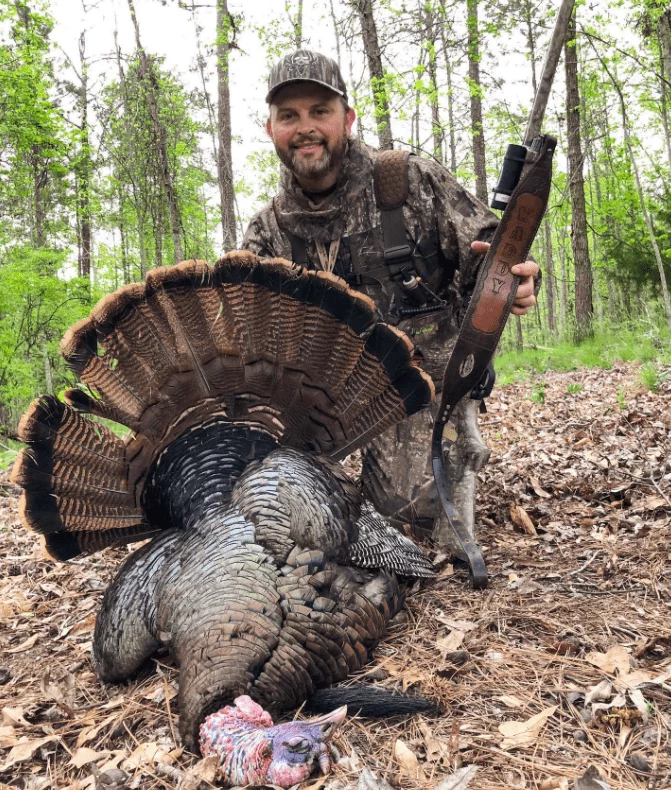Turkey Hunting Strategies to Be Successful
There’s something very special about finally getting back into the woods for spring turkey season. It’s an exciting time to be outdoors! And when you hear that first gobble of the season, you know you get goosebumps. But while it’s nice to eke out as much time as possible for turkey hunting, you also know that your chance of success drops as each day goes by. Sometimes waiting on a bigger tom can mean an empty tag later in the season. So here are some turkey hunting strategies you can use to kill a turkey on opening day this year.
Scouting for Turkeys
Most of us associate the word or activity of scouting with deer hunting. But truth be told, you have a lot to gain when you scout ahead of any kind of hunt, including turkey hunting. It teaches you about what’s going on in your hunting area, including how many birds and what kinds of birds are there, when they’re using an area, and where you could set up your blind. Just as importantly, turkey scouting can show you where you should not hunt. After wandering through a property and not finding any turkey sign, you may want to move on and find a better area instead of potentially wasting your limited hunting time. Scouting turkeys isn’t particularly hard either, but you do need to keep a few things in mind to make it as productive as possible.
Where to Scout for Turkeys
When you’ve narrowed down a couple public or private properties you’d like to hunt, it’s time to move onto field scouting. If you’re like most people, though, you don’t have a ton of time to explore every last inch of them. So one of the best turkey hunting strategies is to focus your time on the areas below.

- Roost Trees – in many ways, roosts are your anchor area. Turkeys nearly always use roost trees to perch in overnight, and will start each day from these elevated areas. But fair warning, turkeys may not use the exact same trees, so plan on locating a few potential sites. Look for mature trees with sturdy horizontal branches. They often have a cleared flight path toward a field or trail. If it’s a real hot spot of a roosting tree, you should be able to find some turkey droppings or feathers underneath the limbs. Take note of such a tree when you find it.
- Fields and Timber Openings – for spring turkeys, the name of the game is strutting for attention. This is why fields and timber openings are often so great for hunting. Hens will be drawn to these areas to feed, while toms will use the areas to strut for hen attention. Walk the edges of fields and woodland openings to scout for tracks, feathers, or droppings – anything that will let you know the birds have been there recently. If you can watch a field from a roadside, try monitoring it early in the morning before your hunting season opens. You might see them pitching down from specific roost trees or watch the way they move across a field. That will come in handy later.
- Trails – another great place to scout is along trails and minimum maintenance road systems. You can usually find some turkey tracks in the soft mud or gravel that will give you clues about the turkey activity there, which direction they tend to move, etc. For bonus points, these trail systems often green up with clover, strawberry, and other plants ahead of most areas, so they may be attractive feeding areas for turkeys in the spring.
Using Trails Cameras for Turkeys
As mentioned above, you’d probably prefer to use your limited time off for hunting instead of only scouting for turkeys. But if you have a lot of properties to scout, you might feel like you don’t have a choice. That’s when trail cameras can be one of your best turkey hunting strategies yet. Very few hunters think about using trail cameras for turkeys, but they work just as well for them as whitetails.
With trail cameras, you can monitor the best places to hunt turkeys very easily and without having to be there. This reduces the pressure you put on the property because you’re not out there potentially spooking birds. It also allows you to simultaneously check several spots at the same time, which you obviously can’t do yourself. The advantage swings further in your direction when you can use cellular or wireless trail cameras because pictures and videos are sent to your device without having to be on the property at all – there’s no need to go and swap SD cards. Set it up early enough in the spring, and you will have no disturbance prior to turkey season – just 24/7 monitoring leading up to opening day.
The Bushnell® Impulse cellular trail camera is a particularly great option. It’s capable of taking one picture per second or great videos too, so you don’t miss any big toms as they strut past your camera. It can also sort photos based on weather and wind data, which may just help you narrow down the right hunting window. You can choose either AT&T or Verizon as an option, depending on which one has better coverage in your hunting area.

Opening Day Routine
After you’ve scouted and monitored properties, taken note of a nice tom or two, and decided on the one you’re going to hunt, it’s time to get serious about your opening day turkey hunting strategies. What you do on opening morning can ruin or enhance all your previous work, so don’t blow it in the fourth quarter.
- Gear and Your Turkey Shotgun – Make sure your turkey shotgun is patterned with the right turkey load, choke, and is throwing a quality pattern to the distances you expect and want out of your gun. Hornady and BC Carlson Choke Tubes make a deadly combination out of Michael’s setup! Make sure you have shells, one is loaded, and you are ready to capitlize on an opportunity around fly down!
- Stealth Mode – when you arrive at your hunting area, be aware that sounds travels a lot further in the pre-dawn stillness. Don’t slam your truck doors, talk noisily on the phone, or start up an ATV. Plan on sneaking quietly into your hunting area, using cover to hide your approach.
- Shock Gobble – even though you have a good idea where the turkeys should be, it helps to try to roost them before you set out. A shock gobble helps to pinpoint a turkey’s location. A barred owl call works great in the early darkness, but crow calls can work well too. Just give a blast on the call and then listen intently to hear which direction the turkey gobbles echo back from. Roosting turkeys is one of the easiest turkey hunting strategies out there.
- Avoid the Bedroom – unless you have a lot of cover, it can be tough to try hunting turkey roost trees. Make sure your approach doesn’t bring you past any suspected roosts, and try to keep your blind at least 75-100 yards away from these areas.
- Know Your Audience – if you’ve been able to monitor the birds on your property, you probably have a good idea if they’re fired up, vocal, and ready to breed. In those cases, feel free to get aggressive with your turkey calling. But if the turkeys seem to be quieter (particularly on public or pressured properties), don’t overdo the calling. It may help to play the ambush game and not call at all.
- Be Flexible – when the turkeys have moved out or changed their plans, it can be helpful to change yours. Identify a few locations ahead of time that might work to set up your blind. Don’t be afraid to move if it’s a quiet morning with no calls or action. Just head to location B and start again.
This spring, we hope you can put these turkey hunting strategies to good use. If you want to maximize your time afield and wait for a truly big longbeard, then by all means, do it. It’s time well spent. But if you want to get a tom as soon as possible, maybe opening morning, try these turkey hunting tips out.


